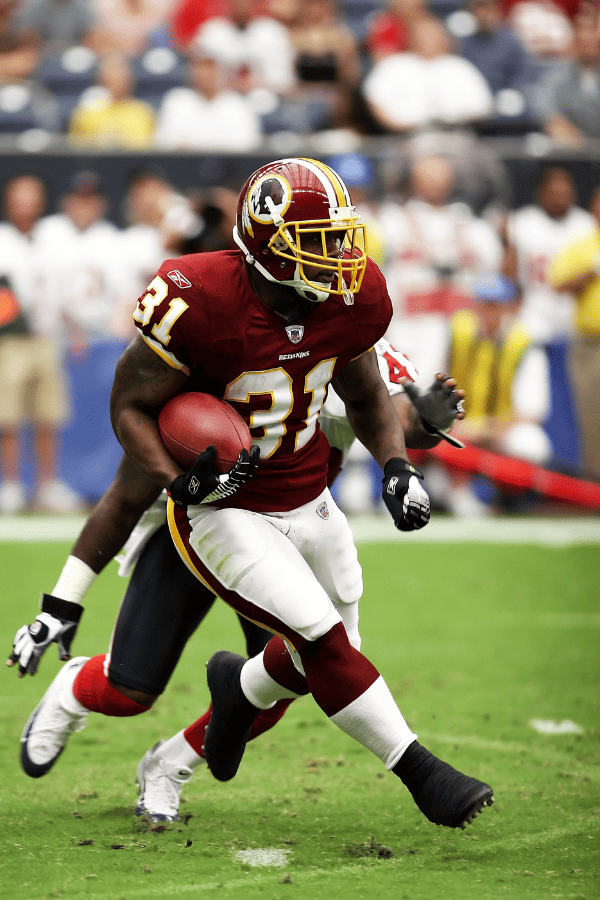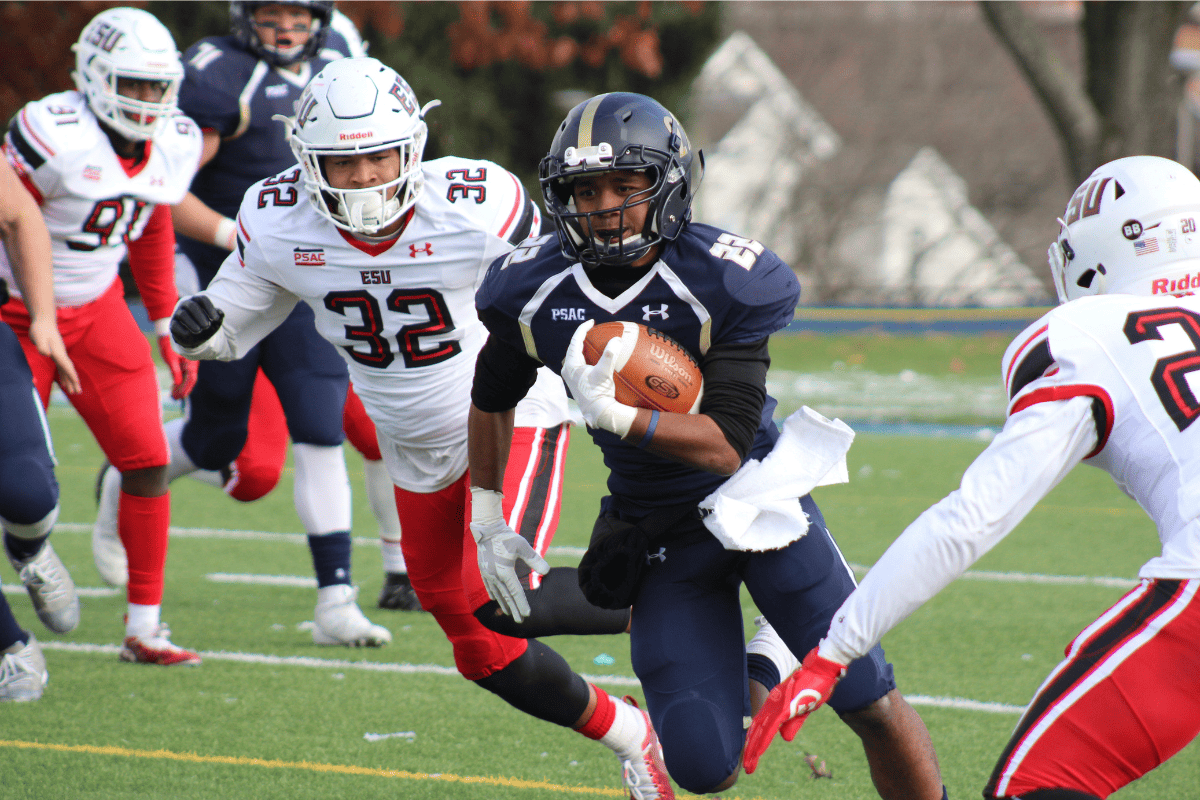What Does a Running Back Do in Football? (Simply Explained)
In American football, a running back (RB) is a member of the offensive backfield. The running back position is typically split into two “sub-positions”: halfback (also referred to as a tailback) and fullback (FB), both having slightly different roles depending on the particular play and offensive strategy.
The primary roles of a running back include rushing the football, catching passes out of the backfield, blocking for the quarterback, and sometimes even acting as a decoy to distract the defense.
The importance of a running back in a football game cannot be overstated. As versatile players, they provide the offense with multiple strategic options, making the team’s attack more unpredictable and dynamic.
A talented running back can be a real game-changer, providing the ability to move the chains and keep drives alive, create big-play opportunities, and ultimately score touchdowns.
Role of a Running Back
A running back is a linchpin in the offensive gameplan of a football team.
Primarily, their role is to advance the ball towards the opposing team’s end zone, either by rushing or receiving the ball. However, their responsibilities extend beyond just handling the football. They are also required to block defensive players during passing plays, protecting the quarterback.
Additionally, running backs can act as decoys to distract the defense, opening up opportunities for other players. They may pretend to take a handoff (called play-action) and draw defenders toward them, creating space for other offensive plays.
Overall, their multi-faceted role adds a significant layer of complexity to the offensive strategy.
Rushing the Football

The most visible role a running back plays is that of a rusher. When a running back rushes, they receive a direct handoff from the quarterback and aim to advance the ball as far downfield as possible.
This requires a combination of speed, power, agility, and vision. The running back must find and exploit gaps in the defense, evade tackles, and, when necessary, use their strength to push through defenders.
Successful rushing plays can gain significant yardage, advance the ball into scoring position, or even result in touchdowns.
Receiving the Football
In addition to rushing, running backs often act as receivers.
They can catch short passes in the backfield, known as screen passes, or go out for longer passes, acting as an additional receiver. This gives the quarterback another option when the primary receivers are covered.
Running backs with good receiving skills add an extra dimension to the offense, as they can turn short passes into big gains by using their running skills after making the catch. This dual-threat ability makes them unpredictable and hard to defend against, adding a level of versatility to the team’s offensive arsenal.
Roles Beyond Ball Carrying
Pass Protection
Running backs are not only crucial in advancing the ball but also play a significant role in pass protection.
During passing plays, if they’re not designated as a receiver, they’re often tasked with protecting the quarterback from incoming defenders known as “blitzers.” These blitzers, if unblocked, could sack the quarterback and result in a loss of yardage, or worse, cause a fumble or injury.
The running back must identify these threats and use their body to block them, allowing the quarterback the necessary time and space to execute a successful pass. This role requires keen awareness, strength, and determination, as running backs are often up against larger defensive linemen and linebackers.
Lead Blocking
Another important, yet sometimes overlooked role of a running back, particularly fullbacks, is lead blocking.
In this role, the running back takes on the role of an additional offensive lineman, clearing the path for other running backs, wide receivers, or even the quarterback during running plays.
They run ahead of the ball carrier, engaging with defensive players to create open running lanes. This role is of paramount importance in many strategies that emphasize the running game.
Effective lead blockers must possess not only strength and toughness but also a clear understanding of the game’s tactics to read the defense correctly and determine the most effective blocking assignments.
While this role may not garner as much attention or glory as rushing or receiving, it is nonetheless integral to a successful running game and a well-functioning offense.
Skills Required for a Running Back
So, what does it take to be a successful running back? Let’s take a look.
Physical Conditioning and Strength

Being in peak condition and strong is of paramount importance for a running back. Football is a physically demanding sport, and running backs need to be able to withstand the constant battering from defensive players over the course of a game.
Strength is critical not only to withstand these hits but also to break tackles, push through defensive lines during rushing attempts, and effectively block opponents during pass protection or lead blocking.
Agility and Speed
In addition to strength, running backs require exceptional agility and speed.
The ability to change direction quickly, called cutting, is a key skill that allows running backs to evade defenders and find gaps in the defensive line. Speed, on the other hand, helps them to exploit these gaps and gain significant yardage before the defense can react.
It’s these bursts of speed, combined with nimble footwork, that often lead to the most exciting plays in a football game.
Football IQ and Vision
A high level of tactical knowledge is crucial for a running back. They must understand various offensive plays, their role in each, and how defenses might react. Furthermore, running backs need excellent vision to identify and exploit gaps in the defensive line.
This ability to read the game, anticipate the movements of defenders, and make split-second decisions is what separates good running backs from the great ones.
Catching and Blocking Ability

As previously discussed, running backs are often used in the passing game, either as a receiver or as a blocker. Hence, they need to have reliable hands to catch passes and sufficient blocking skills to protect the quarterback or open up running lanes for other players.
These skills require not only physical prowess but also technical ability and practice. A running back who can both catch and block effectively is a valuable asset to any team, as they bring versatility and unpredictability to the offensive strategy.
Running Back’s Role in Different Offensive Strategies
Running backs’ roles can vary quite a bit depending on the type of offensive scheme a team runs. Here are a few examples of how their role can change depending on the type of offensive strategy.
Role in a Run-Heavy Offense
In a run-heavy offense, the running back takes center stage. The strategy here is to control the clock and wear down the opposing defense by running the ball frequently.
In such an offense, the running back is expected to carry the ball numerous times, gaining yards through rushes more often than receptions. The running back, particularly a power running back or a fullback, will be relied upon for their strength and durability, as well as their ability to gain consistent yardage and secure first downs.
This type of strategy often relies on a robust offensive line and a running back’s ability to find gaps and exploit them.
Role in a Pass-Heavy Offense
In a pass-heavy offense, the running back’s role will usually be quite different. They might not carry the ball as often as in a run-heavy offense, but they still play an essential part.
Running backs in such an offense often have strong receiving skills and are used as an extra pass-catching option for the quarterback. They can catch short screen passes or even run longer routes, adding another layer to the passing game.
Additionally, pass protection becomes a critical role, as the running back must be able to block incoming defenders to give the quarterback time to find open receivers downfield.
Role in Balanced Offensive Strategies
In balanced offensive strategies, where the aim is to mix up running and passing plays effectively, the running back must be a jack-of-all-trades. They should be proficient in rushing, receiving, and blocking, as the strategy can shift depending on the game situation, the specific play called, or the defensive setup.
This type of offense values running backs who are versatile and adaptive. A balanced offense can keep the defense guessing, and having a running back who can effectively rush, receive, and block is crucial to its success.
This role requires not just physical and technical skills, but also a keen understanding of the game and the ability to make quick, effective decisions under pressure.
Notable Running Backs in NFL History
Many running backs have left their mark on the sport with their exceptional skills and memorable performances. Here are a few:
- Jim Brown: An iconic figure in American football, Brown played for the Cleveland Browns in the NFL from 1957 to 1965. He is renowned for his power, speed, and agility, leading the league in rushing yards in eight of his nine seasons. Brown’s career is marked by numerous records and a relentless playing style that epitomizes the running back position.
- Walter Payton: Known as “Sweetness,” Payton played for the Chicago Bears from 1975 to 1987. His agility, speed, and power made him one of the most prolific rushers in NFL history. He held the record for the most career rushing yards for many years and was known for his versatility as he was also an excellent receiver and blocker.
- Emmitt Smith: Playing primarily for the Dallas Cowboys from 1990 to 2004, Smith became the NFL’s all-time leading rusher. His strength, vision, and durability helped him sustain a long and productive career, and his performance was a key factor in the Cowboys’ success during the 1990s, including three Super Bowl victories.
The careers of these legendary running backs showcase the importance and multifaceted nature of the position. They exemplify the perfect blend of rushing ability, receiving skills, blocking prowess, strength, agility, speed, durability, and game understanding.
Their individual achievements underline the critical role that a running back plays in the team’s offense and the impact they can have on the overall game.
Their careers serve as an inspiration for aspiring running backs and provide a blueprint of the skills and qualities necessary to excel in this crucial position.
Final Thoughts
The running back is a pivotal player in football, having a substantial impact on both the team’s offensive strategy and overall game. Their primary role involves advancing the ball, either by rushing or receiving.
However, they also take on the critical responsibilities of pass protection and lead blocking, contributing to both the passing and rushing aspects of the game.
Running backs need a unique blend of physical strength, agility, speed, and technical skills, as well as a deep understanding of tactics and excellent vision to excel in their role. Their performance can often tip the scales in favor of their team, underlining their importance on the field.
Today’s running backs are often expected to be proficient receivers and blockers, in addition to their rushing duties. This evolution adds more depth to the position and increases its value within the team.
As the game continues to develop, we can expect the role of the running back to adapt and remain a vital element in the exciting world of football.

